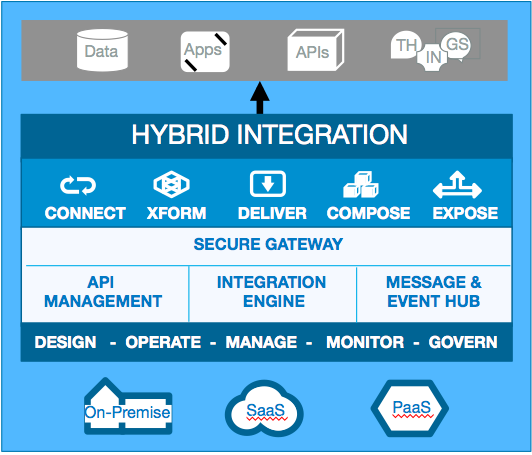Maneuvering a mix of cloud and on-premise applications can be a treacherously difficult task. As every computer application is made up of different elements to exchange data and converse with different applications. Cloud-based applications travel dynamically with the help of workflows opposite to the rule based movement of on-premise applications. Here are some reasons which prevent organizations from making the most out of their hybrid It infrastructure.

Why are the wheels not rolling smoothly?
- LOB Automation is rapidly spawning data silos.
- Data is proliferating exponentially during the course of business transactions.
- System records have become inaccessible and confined in remote corners.
- The network and connectivity don’t have enough bandwidth.
- Lack of a layered approach to secure data access.
- Difficulties in scaling the systems horizontally or vertically.
Complexity: Businesses are embracing hybrid integration at a rapid pace aiming to foster new ways of working. However, the path to automating the Line of Business (LOB) is full of perils and many complexities surface to the ground as cloud-based services are rarely found in non-cloud systems. Application diversity and variety make it difficult for a business user to deliver data to the desired source.
Data Connectivity: Data connectivity is the prominent challenge which businesses encounter in a hybrid environment. A plethora of communications and interactions between a different set of software overloads the data transport channels established between SAAS and legacy systems. Another big difficulty is ensuring secure access to external users at all times. Data duplication, data errors are some other gray areas in this concern.
Legacy Problems: Conventional and legacy system are not specifically built to cover future business needs and technology challenges. This is a real time problem for companies moving away from CAPEX to OPEX models. For example, non-cloud deployments rarely have dynamic scaling capacity, unlike cloud-based deployments. Hence, the systems refuse to play with each other.
After deploying systems in the virtual ecosystem, businesses still have many confidential data assets stored in years old physical data bases. The combination of old and new yet siloed data stops businesses to make the most of their investment and scaling the business as per growing needs.
The Absence of a Platform: Let’s take the example of a Pharma company to explain this technological challenge. Clinical Research Officers (CRO) and Pharma companies lack a platform to convert data and later on submitting it to the FDA. That’s why, companies face delays in the drug discovery process, regulatory fines, and reduced profit margins. Lack of data management platform is a valid reason that prevents Pharmaceutical companies from driving profitability.
Lack of Data Modelling Features: Without data modeling features, it becomes difficult for business leaders to relate data with actionable insights. It is impossible to correlate data and spot issues out of it in such scenarios. Business leaders fail to derive meaning out of high volumes of data, create opportunities, and improve product quality without data modeling features.
Deployment: The deployment becomes difficult when the there is a lack of an integration portfolio spread across applications sprawling across physical and virtual ecosystems. In such scenarios, hybrid environment fails to add value to the investment as critical business operations like creating composite applications, partner data exchange and customer or supplier on-boarding become an uphill challenge.
Compatibility: Compatibility is yet another stumbling block in a hybrid environment as different security, and connectivity controls are deployed in systems. Some of the popular faceoffs occur when different data transport poles collide to teleport data, i.e., Salesforce vs. SAP, Oracle e-Business Suite vs. Workday, Cisco Webex Vs. Lawson, etc. That’s why it is better to consider different technology stacks to avoid compatibility issues at the later stage.
As an organization deploys cloud-based systems, then it also creates a hybrid IT ecosystem which becomes difficult to manage. Manual methods to integrate the cloud and on-premise systems are time and cost intensive. Experts recommend to use integration tools for bridging the great divide between disparate systems. However, finding a comprehensive and sustainable hybrid integration tool for the business case is an intense business challenge. To select the right tool, organizations must prepare a strategy beforehand. In our next blog, we will discuss a checklist for selecting an integration tool of that covers impending business needs.







